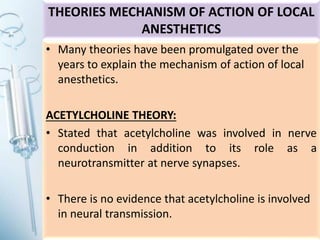

Topical application and direct infiltration anesthetizes the immediate area. Local anesthesia provides reversible blockade of nerves, leading to loss of sensation of pain. Michelle DiBaise, in Essential Clinical Procedures (Second Edition), 2007 BACKGROUND AND HISTORY There were no reports of more serious complications, such as persistent neurologic injury, deep infection, or epidural hematoma. With over 300 neuraxial catheters placed, the most common complications were catheter malfunction, catheter contamination, and vascular aspiration, which were all managed by removal or adjustment of the catheter. An observational study utilizing the Pediatric Regional Anesthesia Network (PRAN) was able to evaluate the incidence of complications related to the use of neuraxial catheters in patients under one month of age. Despite the ability to perform these procedures, there has long been concern over the safety of these techniques in the neonatal patient.

Epidural catheters allow for the continuous infusion of local anesthetic intra- and postoperatively, thereby minimizing the need for analgesics that may result in respiratory depression or may have altered pharmacokinetic properties in the immature neonate. The use of neuraxial catheters, including thoracic, lumbar, and caudal epidural catheters, has the ability to provide an alternative strategy for pain control in the neonate. This technique seems to be well tolerated without significant hemodynamic effect. With the continuous technique, the catheter can be threaded up into the epidural space, often high enough to give midthoracic anesthesia if needed. A catheter can also be threaded into the epidural space for continuous caudal anesthesia.

Caudal anesthesia requires a higher dosage of anesthetic, so the possibility of an inadvertent intravascular injection is a concern. The single shot technique utilizes a 22-gauge, short-bevel needle or 22-gauge angiocath to enter the caudal space.
#Ideal administration rate for local anesthetics free#
After a caudal anesthetic with bupivacaine or ropivacaine, most infants are free of pain immediately after surgery, with relief continuing for at least 3-4 hours. Caudal anesthesia given as a single injection is commonly used in combination with a general anesthetic to allow for lower concentrations of inhalational agents as well as provide postoperative pain control. The epidural space can be entered by the caudal route through the sacrococcygeal membrane. An indwelling catheter also can be placed in an intrapleural location by the surgeon and continuous infusion of bupivacaine given after thoracotomy.Ĭaudal anesthesia is a useful option for surgeries involving the lower abdomen, groin, and lower extremities. Intercostal nerve blocks can be used for thoracotomy and flank incisions use of ultrasound-guided paravertebral blocks may be used in these cases. 27Ĭaudal anesthesia is often used with inguinal hernias, although an ilioinguinal nerve block can be done with ultrasound guidance and may provide a longer duration of analgesia. Transversus abdominis plexus (TAP) blocks and rectus sheath blocks can be used to obtain anterior abdominal wall anesthesia and periumbilical anesthesia for abdominal surgeries such as umbilical hernia. 8 Other indications for use of EMLA include venous and arterial puncture, lumbar puncture, suprapubic puncture, and minor surgical procedures. When used for circumcision, EMLA is more effective than no anesthesia, but it is not as effective as DPNB. Eutectic mixture of local anesthetic (EMLA) cream also has been used for neonatal circumcision. Other simple methods such as a sucrose-dipped pacifier, or a padded and physiologic restraint chair, further decrease objective signs of distress during circumcision performed with DPNB. Local infiltration or nerve block is useful in certain specific procedures such as circumcision where a dorsal penile nerve block (DPNB) or penile ring block has been shown to be safe and effective. There are inherent technical difficulties to performing regional anesthesia in neonates, including the need for appropriate-sized catheters and the need for specialized training to perform these blocks safely and successfully. 60,61 Regional techniques are most commonly combined with general anesthesia, with the primary indication control of postoperative pain and decreasing postoperative analgesic requirements. 22,40 Widespread availability of ultrasound has made it both easier and safer to perform regional blocks in children. Martin MBBS, FRACP, in Fanaroff and Martin's Neonatal-Perinatal Medicine, 2020 Local and Regional AnesthesiaĬoncerns about the neurotoxicity of general anesthetic agents have awakened new interest in regional anesthesia in children and neonates.


 0 kommentar(er)
0 kommentar(er)
